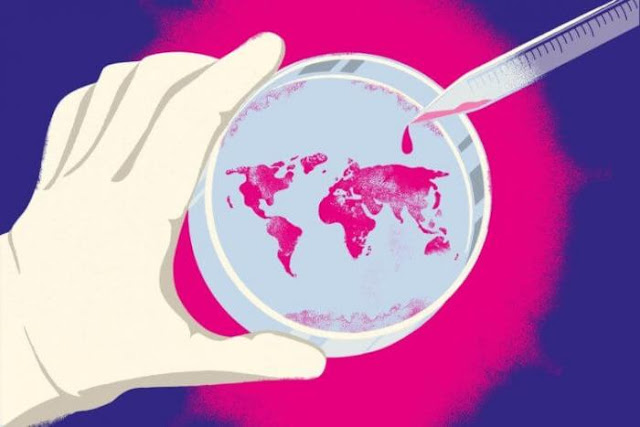Closely monitoring the spread of CoVID-19. At the time of this writing, the number of people infected worldwide has exceeded 180,000. However, even despite the unprecedented quarantine measures taken by governments of different countries, many are convinced that the new coronavirus is no worse than seasonal flu. As arguments, statistics are often given for other infectious diseases - including HIV and measles. And if it seems to you that comparing data on a new coronavirus that appeared four months ago with normal flu is a bad idea, you are right. In this article, we explain why the new coronavirus cannot be compared with the flu and why it is time to take the pandemic seriously.
Pathogen - any environmental factor that can cause damage to body systems or the development of diseases.
How to determine the ability of viruses to spread?
To understand why the flu and the new coronavirus are two different things, you should start with what the virus is. In simple words, a virus is an information system encrypted in DNA or RNA, surrounded by a protective shell. The protective membrane consists of protein and helps viruses survive and multiply, allowing them to “travel” from one cell to another. You could even say that in a sense, viruses are parasites, because in order to survive they need a living organism - be it an amoeba or a person.
However, viruses are very different from each other, and their most important characteristic is the ability to reproduce or infectious. To determine how infectious a particular pathogen is, scientists use the base reproductive number R0, where R0 is the number of people that one infected person can infect. So, in 2003, at the beginning of the SARS epidemic, a severe acute respiratory syndrome, the value of R0 was more than three, but a year later it fell to 0.3 and the epidemic came to naught. As for other viruses, in hepatitis C R0 is 2, in HIV infection R0 = 4, in measles R0 = 18, and in mumps R0 = 10. In other words, the higher the R0 value, the more contagious the virus is. In karonavirus = 3.5 R0 , which means that one sick infects an average of more than three people.
How contagious is seasonal flu?
In 1918, the H1N1 flu virus caused the worst pandemic in history. Better known as “Spaniard,” he claimed the lives of 50 million people. The high pathogenicity of the Spanish woman and the exceptional circumstances of its spread - which we described in detail in our special material - have changed the world. Today, new strains of the flu appear every year, and given the tendency of this virus to mutate, the best we can do is get vaccinated regularly. And yes - vaccinations are good, but the pros and cons can be found here.
Crowded hospitals during the Spanish Flu pandemic, 1918
However, even though the vaccine is available, the flu continues to take many lives. According to the World Health Organization (WHO), in the fall and winter in the Northern Hemisphere, the flu virus infects 5 to 15% of the population each year. Influenza is a contagious infectious disease that is transmitted by airborne droplets or by contact, through hands or objects. Specialists characterize the ability of the flu to spread as high, and the base reproductive number of seasonal flu is R0 = 1.3.
Why is CoVID-19 not a flu and how do they differ?
So, given the fact that seasonal flu is pretty contagious, you might think that it is rightly compared to CoVID-19. But the whole point is that today scientists have much less data on the new coronavirus than on the flu. CoVID-19 appeared at the end of 2019 and overcame two major barriers extremely quickly - animal-to-human transmission (as swine and bird flu did), and subsequent human-to-human transmission. And humanity has been dealing with influenza for a very long time - there is so much information on it on the WHO website alone that you can read it out. In addition, this is the first coronavirus pandemic in history.
Recall that coronavirus is a family of viruses that is divided into two subfamilies. As of January 2020, 40 species of coronaviruses were detected, including CoVID-19.
Do not underestimate the danger of a new coronavirus
Another important difference between influenza and coronavirus is the fact that the majority of the population has developed immunity to the influenza virus over time. In addition, after the transferred flu, we develop lifelong immunity - both against the transferred strain and all its close “relatives”. But in the case of the SARS-CoV-2 flash in 2003, everything was different. Since this is a new disease, we simply have not developed immunity to it. Like CoVID-19.
How contagious is CoVID-19?
According to some experts, the new coronavirus can infect up to 70% of the world's population. However, it is important to understand that CoVID-19 is not seasonal in nature - at least not yet - which means that 70% of the world's population can be infected. Again, it is impossible to predict with certainty one or another scenario, as the pandemic is only gaining momentum. Another alarming factor is the lack of stable immunity in those who have been healed of coronavirus - after infection, the risk of contracting the same strain after several months remains. Now let's look at the numbers - according to current WHO estimates, the basic reproductive number of a new coronavirus is R0 = 2.4–4.5, which means that one infected person can infect another 4 people on average. Given a mortality rate of about 3% (whereas the flu is 30 times lower, approximately 0.1%) - it looks a little scary, right? After all, there is a differenceone death per 1,000 people or 3 per 100 ?
What do you think that is shown in this photo - coronavirus or seasonal flu virus? Share the answer in the comments on this article
Even more alarming are the data on the incubation period of the new coronavirus - according to available information, the symptoms of CoVID-19 may appear after 5 to 24 days. In China, cases have been identified where the incubation period was 27 days. Compare this to seasonal flu and its incubation period of 1 to 4 days. At the same time, a person infected with a new coronavirus poses a danger to others during the entire incubation period. Agree, the H1N1 virus and CoVID-19 are very different from each other.
Editorial Comments
“Probably, I closest to everyone from our editorial office felt the reality of what is happening in the world. My child goes to school in Europe, and CoVID-19 was detected in a boy from a neighbouring class in a junior class. This was before the general quarantine: the school was quickly closed (quickly - this is 1 day), we decided not to go outside, not to go without masks and not to touch the elevator buttons, railings, door handles. We’ll stay home for 2 weeks, because we don’t want to infect neighbours or other people, if suddenly a virus came to us from school. We do not touch the car in which the child was taken from the child’s school and the clothes in which he was at school for 3 days. Let the virus, if any, cease to be dangerous.
We order food home, please leave the courier all in the corridor, then pick it up. We remove the food from the gloves and throw it away.
But it turned out that our measures were even redundant. Literally 3 days after what happened at school, the whole country was quarantined - and they did it right. The child studies at home, we only go out with dogs and use gloves and masks. ”












